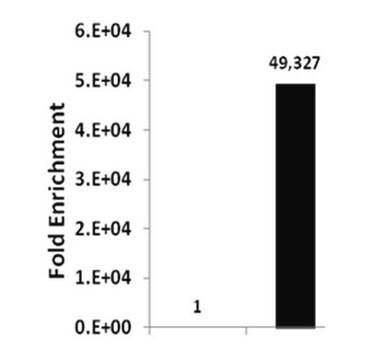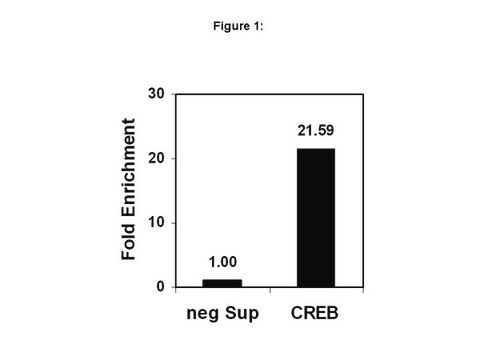17-10057
ChIPAb+ SMRT - ChIP Validated Antibody and Primer Set
ascites fluid, from mouse
Synonym(s):
CTG repeat protein 26, Silencing mediator of retinoic acid and thyroid hormone receptor, T3 receptor-associating factor, Thyroid-, retinoic-acid-receptor-associated corepressor, nuclear receptor co-repressor 2, silencing mediator for retinoid and thyroid
About This Item
Recommended Products
biological source
mouse
Quality Level
antibody form
ascites fluid
clone
monoclonal
species reactivity
human, mouse, rat
manufacturer/tradename
ChIPAb+
Upstate®
technique(s)
ChIP: suitable
electrophoretic mobility shift assay: suitable
immunocytochemistry: suitable
immunohistochemistry: suitable
immunoprecipitation (IP): suitable
western blot: suitable
isotype
IgG2aκ
NCBI accession no.
UniProt accession no.
shipped in
dry ice
Gene Information
human ... NCOR2(9612) , TRAC(28755)
General description
The ChIPAb+ SMRT set includes the SMRT antibody, a negative control mouse ascites, and qPCR primers which amplify a 299 bp region of human IκBα promoter. The SMRT and negative controls are supplied in a scalable "per ChIP" reaction size and can be used to functionally validate the precipitation of SMRT-associated chromatin.
Specificity
Immunogen
Application
Sonicated chromatin prepared from serum starved, TNFα treated (20 ng/mL, 30 min) HeLa cells (~3 X 106 cell equivalents per IP) were subjected to chromatin immunoprecipitation using 2 µL of Negative Ascites or 2 µL Anti-SMRT) and the Magna ChIP G Kit (Cat. # 17-611).
Successful immunoprecipitation of SMRT associated DNA fragments was verified by qPCR using ChIP Primers, IĸBα promoter as a positive locus, and β-Actin promoter primers as a negative locus (Please see figures).
Data is presented as percent input of each IP sample relative to input chromatin for each amplicon and ChIP sample as indicated.
Please refer to the EZ-Magna ChIP A (Cat. # 17-408) or EZ-ChIP (Cat. # 17-371) protocol for experimental details.
Western Blot Analysis:
Representative lot data.
Human brain lysate was resolved by electrophoresis, transferred to PVDF membranes and probed with Anti-SMRT (1:1000 dilution).
Proteins were visualized using a Goat Anti-Mouse IgG conjugated to HRP and a chemiluminescence detection system (Please see figures).
Epigenetics & Nuclear Function
RNA Metabolism & Binding Proteins
Packaging
Quality
Sonicated chromatin prepared from serum starved, TNFα treated (20 ng/mL, 30 min) HeLa cells (~3 X 106 cell equivalents per IP) were subjected to chromatin immunoprecipitation using 2 µL of Negative Ascites or 2 µL Anti-SMRT) and the Magna ChIP® G Kit (Cat. # 17-611).
Successful immunoprecipitation of SMRT associated DNA fragments was verified by qPCR using ChIP Primers, IĸBα promoter (Please see figures).
Please refer to the EZ-Magna ChIP A (Cat. # 17-408) or EZ-ChIP (Cat. # 17-371) protocol for experimental details.
Target description
Physical form
Negative Ascites (mouse). One vial containing 50 µL of mouse ascites with 0.05% sodium azide. Store at -20°C.
ChIP Primers, IκBα promoter. One vial containing 75 μL of 5 μM of each primer specific for human IĸBα promoter. Store at -20°C.
FOR: GAC GAC CCC AAT TCA AAT CG
REV: TCA GGC TCG GGG AAT TTC C
Storage and Stability
Analysis Note
Includes negative control mouse ascites and primers specific for human IκBα promoter.
Legal Information
Disclaimer
Storage Class Code
10 - Combustible liquids
Certificates of Analysis (COA)
Search for Certificates of Analysis (COA) by entering the products Lot/Batch Number. Lot and Batch Numbers can be found on a product’s label following the words ‘Lot’ or ‘Batch’.
Already Own This Product?
Find documentation for the products that you have recently purchased in the Document Library.
Our team of scientists has experience in all areas of research including Life Science, Material Science, Chemical Synthesis, Chromatography, Analytical and many others.
Contact Technical Service








